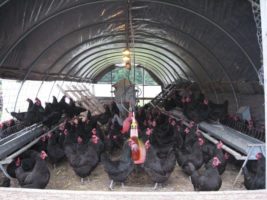Kingbird Farm

| Rating |      |
| Farm/Brand Headquarters | Berkshire, NY |
| Website | https://kingbirdfarm.com/ |
| Market Area | NY |
| Total Score | 1670 |
Kingbird Farm is a model diverse organic family farm in upstate New York with a flock of 300 laying hens on rotated pasture. Their eggs are available year-round at Greenstar Cooperative Market in Ithaca, NY.
They write: “We are a diverse small farm located just south of Ithaca New York. We offer a wide variety of organic poultry, meats, vegetables, and herbs that are certified organic by NOFA-NY Certified Organic LLC. Our farming methods are based on a belief in the sustainability of diversified, small family farms managed with a respect for the land and the animals we raise on it. Our land has been certified organic for twelve years and we manage our land with crop rotation, cover crops, compost, and rotational grazing.”
This farm is certified by the Real Organic Project.
| Criteria | Points | Comment |
|---|---|---|
| TOTAL (possible score is 1700) | 1670 | 5-egg      |
|
Brands that have close daily control over their egg production receive the most points. Ownership Structure | 100 | Single farm |
|
Brands that only produce organic products make the biggest investments — in time and money — in systems that benefit us all. Eggs sourced from a single operation receive the most points. Eggs of unclear origins and/or with poor oversight receives the fewest points. Commitment to Organic Label | 100 | Highly committed to organic label |
|
Additional certifications, depending on the credibility of the label, can demonstrate a commitment beyond the organic standards. Other Labels and Standards | 100 | Animal Welfare Approved (AWA) |
|
Smaller flock sizes (the number of laying hens per housing structure) offer better animal welfare conditions. Flock Size(s) | 100 | Very small flocks of 50 birds per mobile house |
|
The best housing offers space for natural behaviors and legitimate access to the outdoors through adequate exits. Hen Housing and Exit Areas | 100 | Mobile coops allow all birds to utilize outdoor space |
|
Adequate indoor spacing reduces stress and disease. With less crowding, birds can stretch their wings and more easily perform other natural behaviors. Indoor Spacing | 100 | Hens have ample room to perform natural behaviors year round, summer house allots 11 square feet and winter house allots 6 square feet |
|
High scoring brands provide enough space to allow each hen to fully utilize their outdoor area, and to perform instinctive behaviors without harming the environment. Outdoor Spacing | 100 | Hens have ample room to perform natural behaviors, 50 square feet per hen during summer and 10 square feet in winter |
|
High quality outdoor access includes vegetation, soil, and ample opportunities to forage year-round. Quality of Outdoor Access | 100 | Excellent outdoor access quality with 90-100% vegetation maintained |
|
Birds that are introduced to the outdoors early are more accustomed to spending time outdoors without fear or stress. Outdoor Access Timing | 125 | Introduced to the outdoors at 1 week old; chicks are raised in brooder with secure outdoor access yard |
|
Year-round access to perches, scratching areas, deep litter, novel foodstuffs, and dust bathing contribute to quality of life. Enrichments | 100 | Enrichments are provided along with legitimate outdoor access |
|
Chickens use their beaks to interact with the world. Authentic organic farmers account for this behavior, eschewing beak trimming. Alterations | 100 | Brand does not allow beak tipping or forced molting |
|
Raising chicks on farm or buying them from certified organic hatcheries shows dedication to organic production from start to finish. Chicks and Pullets | 75 | Purchases and raises chicks on-farm |
|
Brands that have low rates of deaths and utilize their spent hens for human consumption or similar score the highest. Deaths, Culls, and Spent Hens | 90 | Death rate below 5%, spent hens used for human consumption |
|
Brands that closely monitor and manage health of soil, native species, and water quality receive the most points. Environmental Impacts | 90 | Diversified farm, manure used as on-farm fertility or sold to other farmers, steps taken for environmental sustainability |
| Feed Sourcing | 90 | Feed source grows much of their grain in neighborhood, and sources locally “as much as possible” |
|
Brands that score well here go above and beyond to ensure the highest animal welfare, taking into consideration their hens’ safety and cleanliness, natural behavior, and stress levels. Animal Welfare | 100 | Excellent animal welfare |
|
Cornucopia believes you have a right to transparency. Top brands share information with Cornucopia via a survey and cooperate with our own independent investigations. Transparency | 100 | Full transparency |
|
Brands do not receive points, but this information is offered for people with soy and/or gluten allergies. Soy free and/or gluten free? | Not soy or gluten free | |
|
Brands do not receive points, but are invited to submit the name of their Accredited Organic Certifier (suppliers may have different certifiers). Organic Certifier (non-scoring) | NOFA-NY | |
|
Extra credit is offered for various practices that go above-and-beyond in some form. Extra Credit | 0 | None |

